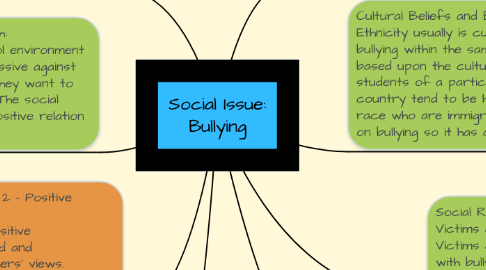Social Issue: Bullying
by Alka Anand

1. Existing Social Condition 1 - Abusive Household: It is often found that kids who have been brought up in an abusive environment tend to become bullies more. Abusive household has a positive relation with bullying
2. Existing Social Condition 2 - Positive upbringing: Kids who are given a positive upbringing are more kind and acceptable towards others’ views. Positive upbringing has a negative relation with bullying
3. Social Inequalities 1 - Rich: Some rich kids in school environment tend to be more oppressive against the not so wealthy as they want to show their superiority. The social inequality of rich has positive relation with bullying sometimes.
4. Social Inequalities 2 - Poor: Kids who are brought up in not so wealthy environment tend to be more sharing and amenable. The social inequality of poor has negative relation with bullying most of the times.
5. Cultural Beliefs and Biases 1 - Race: Race most commonly refers to physical qualities such as skin color or ancestry. Students of minority races within a school environment tend to get bullied more than majority races. Race has a positive relation with bullying
6. Cultural Beliefs and Biases 2 - Ethnicity: Ethnicity usually is cultural beliefs and practices. Ethnic bullying within the same racial group is also predominant based upon the cultural and social beliefs. For example, students of a particular race who are born in a foreign country tend to be hostile towards students of the same race who are immigrants. Ethnicity also has direct impact on bullying so it has a positive relation
7. Social Role 1 - Perpetrator: Perpetrator is the one who initiates the bullying. Perpetrators have positive relation with bullying as they are the instigators
8. Social Role 2 - Victims: Victims are the sufferers of bullying. Victims also have positive relation with bullying as they are affected directly by the bully


